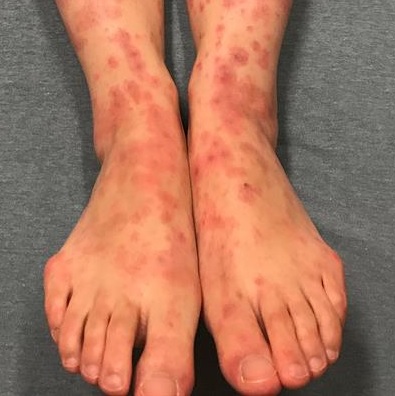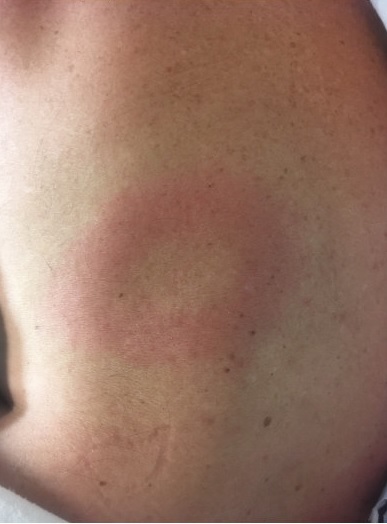Case Presentation: A 42 year old female who was previously healthy presented to hospital for evaluation of rash. The rash had appeared 5 days prior and was pruritic in nature. The rash began on the patient’s chest and face and spread to the rest of her torso and extremities. The rash began as purpuric papules then expanded into numerous small round lesions with dark centers. She reported intermittent fevers to 101F at home over several days. She denied shortness of breath, cough, sputum production, dysuria, abdominal pain and other symptoms.Two weeks prior to admission the patient was started on an oral regimen for H. pylori including amoxicillin and clarithromycin. She also reported a pruritic bug bite on the nape of her neck which occurred 2 days prior to the onset of rash.
The patient was a visitor to the United States from Japan. She lived at home with her husband and 2 young children. The patient reported participating in a recent trail running race. She was unfamiliar with the appearance of the deer tick.
On physical examination the patient had a temperature of 99.4F. Skin examination revealed multiple coalescent, target-like lesions throughout her body including the trunk, arms, lower torso, and legs but not involving the mucosa (image 1).
A skin biopsy was performed and revealed erythema multiforme. A drug reaction to antibiotics was suspected as a likely cause. Due to her outdoor exposure (trail running) and reported insect bite, Lyme disease screening was performed and was positive. Western blot confirmation confirmed acute Lyme disease with 2 of 3 IgM bands present. The patient was prescribed doxycycline for a 14 day course and topical triamcinolone ointment with eventual resolution of symptoms.
Discussion: Erythema multiforme is an acute immune-mediated condition characterized by the appearance of distinctive target-like lesions on the skin. Lyme disease is an acute infection transmitted by the Ixodes tick due to the spirochete Borrelia burgdoferi, characterized by its own distinctive targetoid lesions known as erythema migrans. The lesions of erythema multiforme are usually numerous, small, round, edematous with a dusky center and a ring of surrounding inflammation distributed initially over the extensor surfaces of extremities with subsequent centripetal spread. The lesions of erythema migrans expand into a “bulls-eye” lesion usually arising from the site of the tick bite and may be found near the axilla or groin (image 2). Although both conditions may cause target-like lesions, the cutaneous findings are distinct from each other.
Erythema multiforme is commonly associated with infection, such as by herpes simplex virus, but very infrequently with Lyme disease (only 2 other reported cases). Other causes of erythema multiforme include HIV, malignancy, medications, and sarcoidosis. The clinical course of erythema multiforme is usually self-limited and resolves in most cases without specific treatment. On the other hand, Lyme disease may progress from cutaneous manifestations to inflammatory arthritis, carditis and neurologic complications if left untreated.
Despite the rare association between Lyme disease and erythema multiforme, a high index of suspicion based upon reported outdoor exposure, insect bite and a high local prevalence of Lyme disease led to detection and treatment in this case.
Conclusions: The hospitalist must be aware of erythema multiforme as a cutaneous presentation of Lyme disease, particularly in areas of high prevalence, to prevent late complications.


